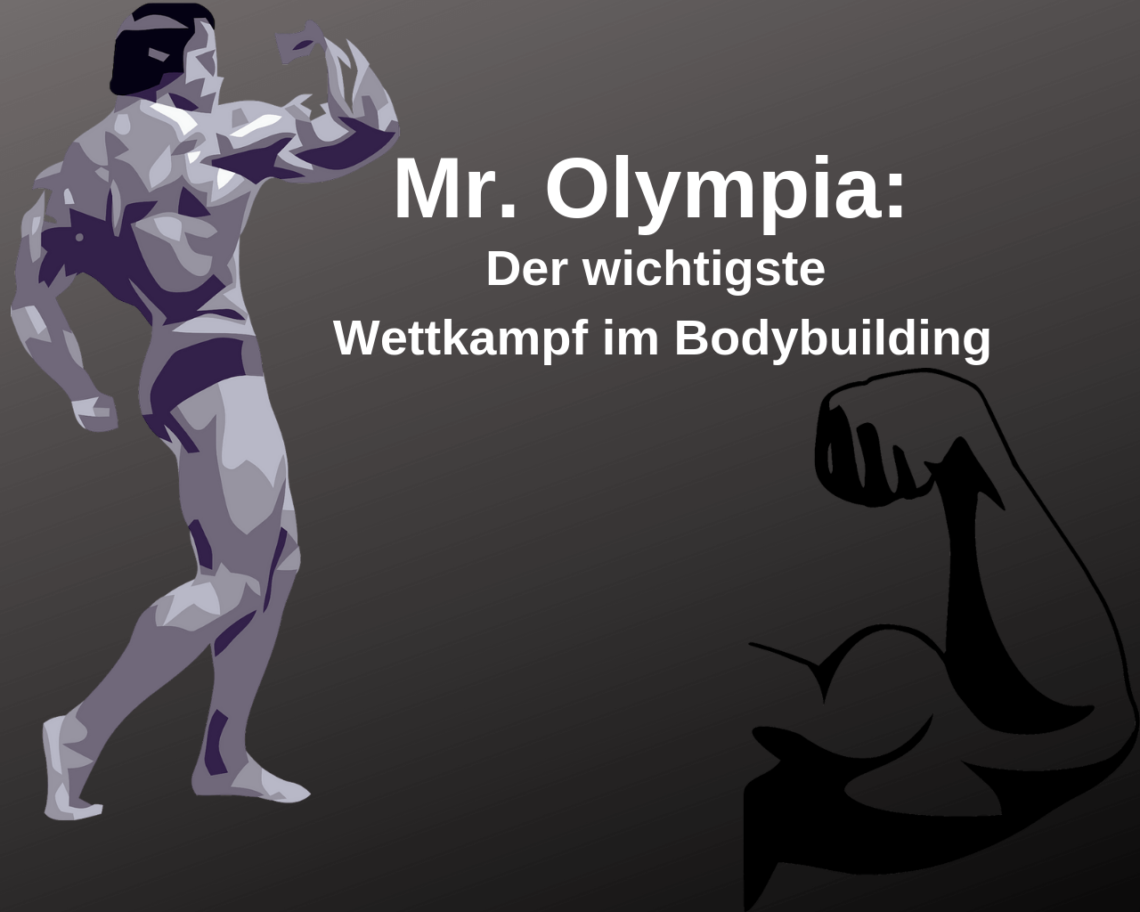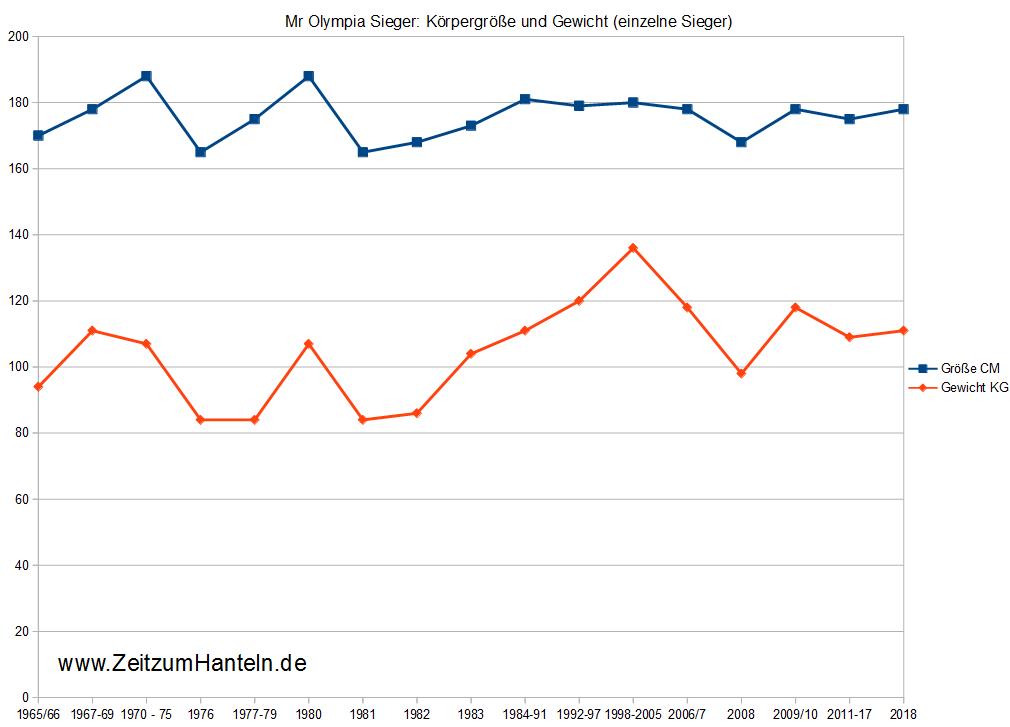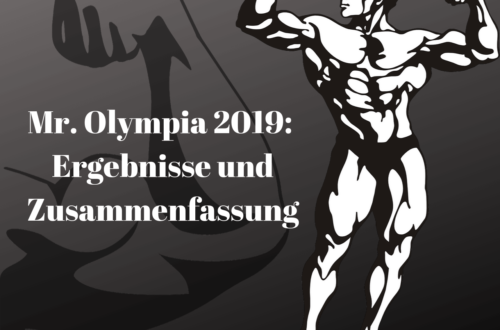
Mr. Olympia: The most important competition in bodybuilding
Ats current occasion, I would like to refer to my post "Mr. Olympia 2019: Results and Summary“Downwise the I will update for you as far as I can.
This year's Mr. Olympia competition will soon take place in Las Vegas, USA, from September 12-15, 2019. The best bodybuilders in the world meet here to compete against each other. In this article you will learn the most important information about the most prestigious bodybuilding competition in the world.
Mr. Olympia: A first introduction
The Mr. Olympia competition was initiated by Joe Weider (co-founder of the most important bodybuilding professional association IFBB and entrepreneur in the field of dietary supplements) so that the best bodybuilder in the world measure with each other. Only athletes who have proven their international class and who have qualified according to the regulations are allowed to take part in this competition.
There are both male and female classes. In this article I will only deal with the male classes. The women's classes and the competition of the Mrs. Olympia will be the subject of another contribution.
The weight classes
In contrast to many other bodybuilding competitions, there were no or very few weight classes at the Mr. Olympia for a long time. Especially in the last few years, a changed public taste has been taken into account and new classes have been introduced.
Generally, the title "Mr. Olympia ”in the men's open weight class and recognized for this. Winners of the other classes operate under names such as "Winner in the 212 pound class" or similar.
Heavyweight und Lightweight
From 1974 to 1979 the field of participants was in Heavyweight (over 200 pounds, approximately 90.7 kg) and Lightweight (under 200 pounds) divided up. The two class winners competed against each other in a final and the new Mr. Olympia was chosen. By today's standards in the open weight class of professional bodybuilding, this is a ridiculous division, considering the general weight development of the participants. I will address these in more detail below.
212 pounds class
In 2008 the 202 pound class (approximately 91.6 kg) introduced. Athletes in this class have been allowed to do so since 2012 212 pounds (about 96.15 kg) to weigh. Read more about the 212 pound class in the relevant paragraph.
Classic Physique
Since the participating athletes of the Mr. Olympia were consistently heavier and more muscular, but not necessarily more athletic, the audience (rightly in my opinion) demanded a new weight class. This class, which was only introduced in 2016, is called "Classic Physique" and has a variable weight limit, which depends on the size of the athlete. Larger athletes are allowed to go on stage with a higher weight than smaller participants.
Men’s Physique
In the open class and the 212 pound class, the athletes are maximally muscular, but often lack an aesthetic line. In 2013, the Men’s Physique was introduced to offer less muscular, more fit and athletic athletes a stage. Here the participants are divided into classes according to their size and wear shorts instead of posing briefs.
The qualification
There are several ways to qualify as a professional bodybuilder for the Mr. Olympia:
Winning the Mr. Olympia
The winner of the Mr. Olympia has a lifelong right to start at ALL following Mr. Olympia competitions.
Top 5 placement in the previous year
Athletes who placed in the top 5 last year are automatically qualified for the next year.
If there are 25 professional competitions or less
If 25 or fewer professional competitions take place in the current year up to the Mr. Olympia in September, in which one can qualify, one of the big shows must be won (one of the Arnold Classics, New York Pro etc.). For each of the first 5 places in a major competition, the athlete receives points. The first 3 places in the points list are also qualified.
In more than 25 professional competitions
If more than 25 professional competitions are held during the qualification for the Mr. Olympia, only former winners and top 5 placed winners from the previous year are directly qualified. The top 20 with the most points obtained from competitions also qualify.
Wildcard
The organizers of the Mr. Olympia have the opportunity to allow individual athletes to participate in the competition with a wildcard. This is granted, among other things, to individual athletes who were unable to collect enough points due to injuries but have already proven their class. Special achievements in the past are sometimes rewarded in this way.
The awarding of points for places 1-5 in the various shows also depends on the size and prestige of the respective show. You can find more information about the complicated scoring process here: https://mrolympia.com/qualification-series
Men's Open
The Men's Open (open men's class) is the first and most important class of the Mr. Olympia. Athletes have been competing in it since 1965, with few exceptions without weight limits.
At the beginning, athletes present 4 quarter turns, followed by the 7 mandatory items (Front Biceps, Front Lat Spread, Side Chest, Back Double Biceps, Back Lat Spread, Abdominals and Thighs, and Side Triceps). Finally, each athlete is allowed to perform a freestyle to music of their choice in order to showcase their strengths in the best possible way. A separate article on the mandatory poses will follow in due course.
Would you like to know more about the posing rules in the open men's class?
Mr. Olympia: The winners of the Men's Open
Here you will find a list of all winners of the Mr. Olympia in the open weight class.
A champion often manages to defend his title for several years. An entire era is shaped by an extraordinary athlete. The division into decades is of course only rough, because some eras lasted beyond a decade.
1960er
In the 1960s, the first competitions took place from 1965. First winner of the Mr. Olympia was Larry Scottwho was able to defend his title once. Followed him Sergio Oliva with 3 titles from 1967-1969, one of the few bodybuilders who could beat Arnold Schwarzenegger.
1970er
The 1970s are the decade of the Arnold Schwarzenegger. He won the title from 1970 to 1975. After a one-time victory by Franco Columbo secured himself Frank Zane (also called "King of Aesthetics" due to its almost statuesque silhouette) the title. Arnold Schwarzenegger was followed by 2 smaller, lighter athletes.
1980er
In 1980, following his trips to Hollywood, Arnold was able to recapture the title in an extremely controversial manner. In the years 1981-1984 3 different athletes won the title, until finally from 1984-1992 the era of Lee Haney followed. Lee Haney was characterized by a greater muscle mass compared to the previous title winners while being in good shape.
1990er
With the era of Dorian Yates (1992 - 1997) finally began the era of the "mass monsters". The athletes became consistently heavier and the amount of muscles grew to previously unimagined sizes. With this increase in mass, however, there was also a loss of aesthetics.
2000s
Frank Zane had won the Mr. Olympia with 84 kg, weighed Ronnie Coleman incredible 136 kg in competition form. It was the highlight of the mass monsters and could win the title 8 times. So he is the Record holder from 1998 - 2005.
2006/2007, 2009 and 2010 won Jay Cutler the title, with a one-year hiatus in 2008 (Dexter Jackson).
2010er
The era of Phil Heath lasted from 2011 to 2018, in 2019 it could Shawn Rhoden to remove from the throne
| 1965 | Larry Scott | 170 cm | 94 kg |
| 1966 | Larry Scott | ||
| 1967 | Sergio Oliva | 178 cm | 111 kg |
| 1968 | Sergio Oliva | ||
| 1969 | Sergio Oliva |
| 1970 | Arnold Schwarzenegger | 188 cm | 107 kg |
| 1971 | Arnold Schwarzenegger | ||
| 1972 | Arnold Schwarzenegger | ||
| 1973 | Arnold Schwarzenegger | ||
| 1974 | Arnold Schwarzenegger | ||
| 1975 | Arnold Schwarzenegger | ||
| 1976 | Franco Columbu | 165 cm | 84 kg |
| 1977 | Frank Zane | 175 cm | 84 kg |
| 1978 | Frank Zane | ||
| 1979 | Frank Zane |
| 1980 | Arnold Schwarzenegger | 188 cm | 107 kg |
| 1981 | Franco Columbu | 165 cm | 84 kg |
| 1982 | Chris Dickersen | 168 cm | 86 kg |
| 1983 | Samir Bannout | 173 cm | 104 kg |
| 1984 | Lee Haney | 181 cm | 104 kg |
| 1985 | Lee Haney | 111 kg | |
| 1986 | Lee Haney | ||
| 1987 | Lee Haney | ||
| 1988 | Lee Haney | ||
| 1989 | Lee Haney | 113 kg |
| 1990 | Lee Haney | 181 cm | 113 kg |
| 1991 | Lee Haney | ||
| 1992 | Dorian Yates | 178 cm | 120 kg |
| 1993 | Dorian Yates | ||
| 1994 | Dorian Yates | ||
| 1995 | Dorian Yates | ||
| 1996 | Dorian Yates | ||
| 1997 | Dorian Yates | ||
| 1998 | Ronnie Coleman | 180 cm | 136 kg |
| 1999 | Ronnie Coleman |
| 2000 | Ronnie Coleman | 180 cm | 136 kg |
| 2001 | Ronnie Coleman | ||
| 2002 | Ronnie Coleman | ||
| 2003 | Ronnie Coleman | ||
| 2004 | Ronnie Coleman | ||
| 2005 | Ronnie Coleman | ||
| 2006 | Jay Cutler | 178 cm | 118 kg |
| 2007 | Jay Cutler | ||
| 2008 | Dexter Jackson | 168 cm | 106 kg |
| 2009 | Jay Cutler | 178 cm | 118 kg |
| 2010 | Jay Cutler | 178 cm | 118 kg |
| 2011 | Phil Heath | 175 cm | 109 kg |
| 2012 | Phil Heath | ||
| 2013 | Phil Heath | ||
| 2014 | Phil Heath | ||
| 2015 | Phil Heath | ||
| 2016 | Phil Heath | ||
| 2017 | Phil Heath | ||
| 2018 | Shawn Rhoden | 178 cm | 118 kg |
| 2019 | Brandon Curry | 172,5 cm | 115 kg |
Weight development of the winner of the Mr. Olympia
As mentioned earlier, from the inception of Mr. Olympia, with exceptions until the 2000s, there was only one direction for the weight of the open class winners: Up.
This was accompanied by a decrease in aesthetics. The fans demanded new weight classes and evaluation standards, which were finally implemented. Let's take a look at the development of the height and weight of the winners of the open class of the Mr. Olympia based on two tables I created.
The first table shows the height in cm and the weight in kg of the winner for each individual year. If the information does not change for a few years, the athlete could defend his title. The second table only shows the sequence of the winners, the years of their title wins have been summarized.
What can we see in these tables?
Since the beginning of Mr. Olympia, the winners of the open class (with the exception of Arnold Schwarzenegger with 188 cm) were almost always around 178 cm tall. However, the weight has steadily increased (with a few exceptions in the early 1970s). Even with the same size or significantly smaller than Arnold Schwarzenegger, the weight of the winners increased, sometimes immensely. Ronnie Coleman weighed up to 136 kg with a height of 180 cm.


Prize money in the open class
As with every professional competition in the world, not only honor and prestige, but also a lot of prize money are distributed to the most successful athlete at the Mr. Olympia. However, the prize money is distributed very differently between the different classes. Here you can see the prize money for the top 3 places in the open weight class.
212 pounds class
In 2008, after a long time, a weight class was introduced alongside the men's open class:
Prize money 212 pounds class
Compared to the open class, there is a clear drop in the prize money. So the winner of the 212 class only receives a tenth of the prize money of Mr. Olympia. See for yourself the prize money of the top 3 placements.
2019
2018
Classic Physique
The Classic Physique class was established at the Mr. Olympia in 2016. The first winner was Danny Hester, followed by Breon Ansley in 2017 and 2018.
The Classic Physique combines a weight limit as in the 212 class with a size classification as in the Men’s Physique. Although there are participants of different sizes facing each other, the weight limit depends individually on the size of the participant. For example, if a participant is up to 168 cm tall, he may weigh his height -100 in kg. At 168 cm, that's exactly 68 kg. For example, if he is 175-180 cm tall, he may weigh his height -100 +6 kg. At 178 cm up to 84 kg.
The participants wear posing trunks. It is judged in round 1 only after 4 quarter turns, then the compulsory 7 bodybuilding poses (a contribution to bodybuilding poses will follow). In round 2, each athlete can perform a freestyle individually.
au/rules/men-s-classic-physique
Prize money in the Classic Physique
The prize money in the Classic Physique is roughly based on the half of the prize money in the 212 class. When you consider that this year this class is only taking part in the competition for the fourth time, not a bad appreciation. Still no comparison to the prize money in the open class.
2019
2018
Men's Physique
The Men’s Physique, also disparagingly referred to as the “swimwear class” for “beautiful kids”, was introduced in 2013. It gives the impression that anyone with enough vigor, talent and bite could achieve such a body.
In contrast to athletes in the open class, class 212 and Classic Physique, the participants of the Men’s Physique are only rated by 4 quarter turns in the first posing round. In round 2, the back and front views are assessed again. The lack of the obligatory bodybuilding poses is another point of criticism, the Men's Physique is actually not a "real" bodybuilding class.
Would you like to know more about the posing rules in the Men’s Physique class?
Men's Physique prize money
The prize money in the Men’s Physique matched the prize money in the Classic Physique in 2018. This may not come as a surprise, but it is noticeable that there is a shift in the weighting of the classes. The Men’s Physique has been held since 2013, the Classic Physique was only established as a new class in 2016. Thus, the Classic Physique has already achieved the status of Men’s Physique and should overtake it in the future. In order to revalue the Men’s Physique, the prize money was increased slightly more in 2019 than in the Classic Physique.
2019
2018
Mr. Olympia and doping
There seems to be a trend to specifically associate bodybuilding with doping. That is certainly not wrong. If you look at these bodies - how could you believe that this performance (whether you find it aesthetically good or bad) could be achieved without performance-enhancing substances. A single Mr. Olympia competition in history was actually doping tested (1990, see the short video). Some athletes did not participate, others were disqualified, still others were easier and in worse shape ...
So that we don't get ourselves wrong: Personally, I completely reject anabolic steroids, especially for recreational and amateur athletes. Here, however, we consider the absolute world elite of bodybuilding sport.
In my opinion there is no real world class sport imaginable in which no illegal or prohibited substances are used (bicycle [Tour de France], swimming, athletics, even curling [beta blockers to keep the hand steady]).
Lots of people think they just have to take something to look like a bodybuilder. I am firmly convinced that 99.9% of all athletes, despite doping, never look like this, let alone perform like these professional athletes in daily training. These world-class athletes have tailored their diet, training, recreation and the whole day to this sport
So if you are a hobby athlete, anabolic steroids shouldn't be relevant to you in my opinion. What's the point of moving 20 kg more in one exercise or having 10 kg more muscle if your health is ruined? If you are making your living doing professional bodybuilding, you should be aware of the risks. I will write my own article on doping in sport at times.
Bodybuilding is perhaps the sport that most openly admits that harmful substances are used to improve performance. Bodybuilding will certainly not be the exception in high-performance sport.
Summary
The Mr. Olympia is the figurehead and the largest and most prestigious competition in the world of bodybuilding. Every bodybuilding enthusiast who follows the professional athletes in this sport is looking forward to this weekend.
Not only in the premier class, the open class of men, great athletes compete against each other. The most diverse body types compete in many different classes and hope that the work and discipline of many years will pay off.
I'm already looking forward to the next Mr. Olympia and to see how world class bodybuilding has improved.
I hope I was able to bring you a little closer to professional bodybuilding and especially the Mr. Olympia.
De liked this article, do you have suggestions or want to say something?
Follow me on social media and write a comment! I look forward to your opinion.


You might be interested in that too

Mr. Olympia 2019: Results and Summary
14. September 2019
Protein - the stuff your muscles are made of!
12. June 2019
Fitness studio: the most important tips for beginners!
14. June 2019Latest posts
- Tampa Pro 2020: Results and Summary 18. August 2020
- Arnold Classic 2020: Results and Summary March 10, 2020
- How do I get back into training after a break from training? January 9, 2020
- Mr. Olympia 2019: Results and Summary 14. September 2019
- Mr. Olympia: The most important competition in bodybuilding 18. August 2019

2 comments
Nobody
Phil Heath was no longer Mr Olympia in 2018. It was Shawn Roden and in 2019 it was Brandon Curry and Shawn Roden wasn't there.
Genry Brown
Hi Micharl, thank you very much for your comment. You're right, of course, because I made a mistake: In 2018 Shawn Rhoden became Mr. Olympia, in 2019 Brandon Curry won the competition. Thanks for your hint, I'll change that in a moment. As soon as I have some time, I would like to bring the old posts up to date.
Best regards
Sebastian